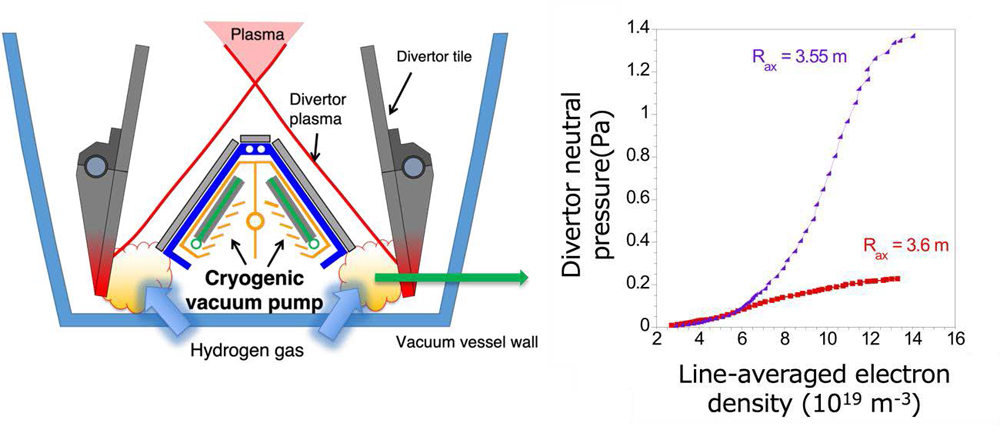Ultra-high neutral pressure achieved in divertor
For the first time, a very high neutral pressure in a divertor region has been observed in a high-density experiment in the Large Helical Device (LHD). Curiously, this phenomenon has only been observed in a specific magnetic field configuration. Divertors play a role in removing impurities and improving particle control by increasing the amount of neutral particles inside and efficiently exhausting them. The present results mean that an optimization of the magnetic field configuration enables an increase of neutral particle pressure in the divertor region, providing important insights into the design of fusion DEMO reactors.

Fusion power generation is achieved by injecting hydrogen fuel into a high-temperature plasma of over 100 million degrees Celsius, where the injected hydrogen becomes hot ions and undergoes a nuclear fusion reaction. The ionised hydrogen (fuel particles) are ejected out of the plasma over time, some bouncing off the walls of the plasma confinement vessel and back into the plasma, and some are exhausted out of the vessel by a vacuum pump. A setup called a divertor system is responsible for maintaining stable plasma by controlling the particles that bounce off the walls of the vessel by drawing in and compressing hydrogen and other fuels. In the relationship between the cage of magnetic field lines confining the plasma (magnetic field configuration) and compression in the divertor, the research team has now discovered that at a specific magnetic field configuration, very high neutral particle pressures are achieved inside the divertor. Previous research has shown that hydrogen fuel can be highly compressed inside the divertor if the position of the center of the plasma (magnetic axis) is inwards. However, this time the magnetic field configuration is shifted to 3.55 m, only 5 cm inwards from the magnetic axis condition (3.60 m), which is commonly used. A neutral pressure of more than seven times higher is achieved.
One of the possible reasons for this is that the plasma inside the divertor is relatively cold, a condition known as volume recombination, and the research team named the ultra-high neutral pressure phenomenon inside the divertor “the low-temperature mode”. The relatively high carbon impurity content is considered to be one of the reasons for the low temperatures, however analysis is currently underway for more detailed understanding. The present results mean that the neutral pressure inside the divertor can be increased by optimization of the magnetic field configuration, which provides important insights for the design of fusion DEMO reactors.
The research was carried out by Uwe Wenzel of the Max-Planck-Institut für Plasmaphysik and Gen Motojima of the National Institute for Fusion Science.
The results of this research were published on 9 February 2024 in Nuclear Fusion, a journal on controlled thermonuclear fusion by the International Atomic Energy Agency.
